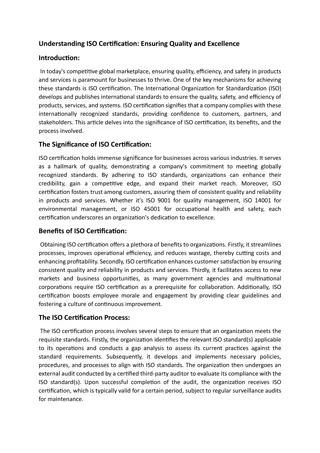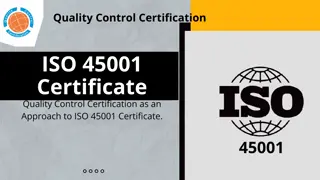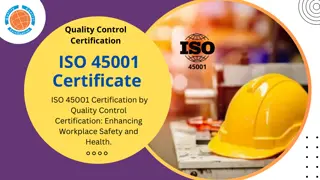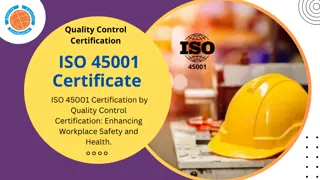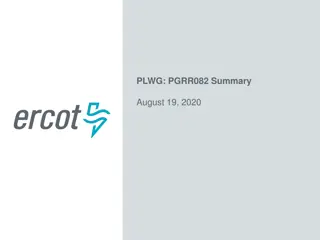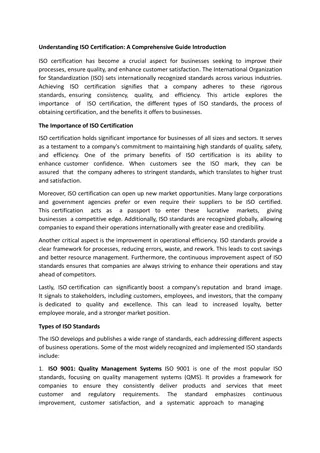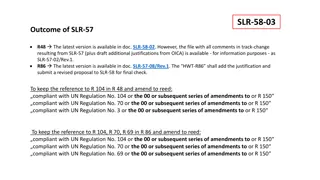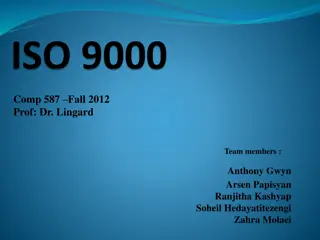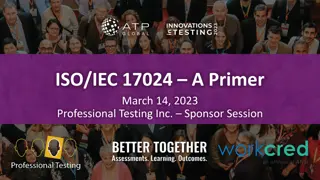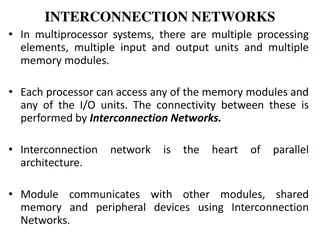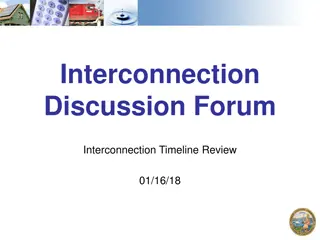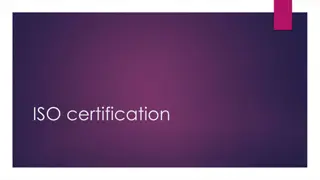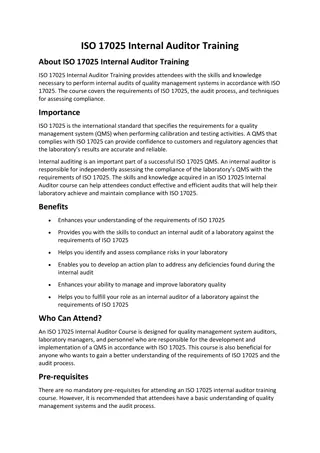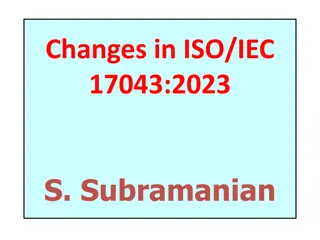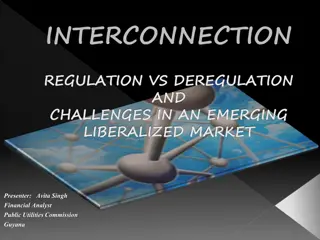Improvements to Generator Interconnection Procedures: ISO New England Response
FERC's Notice of Proposed Rulemaking seeks to enhance generator interconnection procedures to address queue backlogs and promote fairness. ISO New England outlines expansive changes, including a first-ready, first-served process, and discusses trade-offs in project viability and completion expectations for transmission providers.
Download Presentation

Please find below an Image/Link to download the presentation.
The content on the website is provided AS IS for your information and personal use only. It may not be sold, licensed, or shared on other websites without obtaining consent from the author.If you encounter any issues during the download, it is possible that the publisher has removed the file from their server.
You are allowed to download the files provided on this website for personal or commercial use, subject to the condition that they are used lawfully. All files are the property of their respective owners.
The content on the website is provided AS IS for your information and personal use only. It may not be sold, licensed, or shared on other websites without obtaining consent from the author.
E N D
Presentation Transcript
S E P T E M B E R 2 8 , 2 0 2 2 | N E P O O L T R A N S M I S S I O N C O M M I T T E E | W E B E X / T E L E C O N F E R E N C E FERC Notice of Proposed Rulemaking: Improvements to Generator Interconnection Procedures and Agreements ISO New England Initial Thoughts on Responses Al McBride S Y S T E M P L A N N I N G ISO-NE PUBLIC
Introduction On June 16, 2022 FERC issued a Notice of Proposed Rulemaking (NOPR) on Improving Generator Interconnection Procedures and Agreements Docket No. RM22-14-000 To address interconnection queue backlogs, improve certainty and prevent undue discrimination for new technologies The purpose of this presentation is to describe ISO New England s anticipated response to the NOPR and to allow for some discussion with Stakeholders ISO-NE PUBLIC 2
Summary of ISO-NEs Thinking: Expansive Changes The NOPR contemplates a very expansive set of changes to the pro forma Interconnection Procedures First-ready first-served cluster process Only projects that meet significant readiness-requirements would receive a meaningful Queue Position and proceed to the definitive [cluster] system impact study stage of the process Other information would be provided outside of the definitive queue Feasibility Study eliminated Informational studies and other interconnection information outside of the queue Elimination of Reasonable Efforts Standard Penalties on Transmission Providers for failing to meet study timelines ISO-NE PUBLIC 3
Summary of ISO-NEs Thinking: Trade-offs ISO-NE believes that the NOPR appropriately recognizes that significant trade-offs are involved when pursuing such an expansive change Study time focused on fewer projects that are more likely to be constructed Consequences for Transmission Providers that do not complete studies on-time This trade-off must be realistic Higher study completion expectations will require: Only studying projects that are sufficiently viable Less flexibility for midstream project changes Less ability to consider upgrade alternatives No tolerance for inadequate models and data Stricter expectations for the completion of transmission upgrade cost- estimates Stricter expectations for Affected Systems ISO-NE PUBLIC 4
Summary of ISO-NEs Thinking: Regional Differences New England has made several enhancements to the Interconnection Procedures in recent years: Integration with the Forward Capacity Market (FCM) Elective Transmission Upgrades Clustering It will be important to explain that it will be preferable to retain some aspects of these enhancements under allowances for regional differences, which is consistent with the NOPR ISO-NE PUBLIC 5
Summary of ISO-NEs Thinking: Small Generator Interconnections ISO-NE believes that the majority of the proposed changes would need to apply equally to the small generator and elective transmission upgrade procedures and not just to large generators Avoid operating separate queues with fundamentally different expectations in terms of studies and timeframes ISO-NE PUBLIC 6
PROPOSED REFORMS ISO-NE Public Reduced Non CEII Version ISO-NE PUBLIC ISO-NE INTERNAL USE 7
Proposed Reforms Reforms to Implement a First-Ready, First-Served Cluster Study Process Interconnection Information Access/Optional Information Study Cluster Study Allocation of Cluster Study Costs Allocation of Network Upgrade Costs Shared Network Upgrades Increased Financial Commitments and Readiness Requirements Transition Process Reforms to Increase the Speed of Interconnection Queue Processing Elimination of the Reasonable Efforts Standard Affected Systems Optional Resource Solicitation Study Reforms to Incorporate Technological Advancements into the Interconnection Process Increasing Flexibility in the Generator Interconnection Process Incorporating Alternative Transmission Technologies into the Generator Interconnection Process Modeling and Performance Requirements for Non-Synchronous Generating Facilities ISO-NE PUBLIC 8
Informational Interconnection Study Summary of NOPR Proposal To help prospective interconnection customers determine whether they want to enter the queue, they may request up to five (5) informational interconnection studies at a time, with a $10,000 deposit per request Each informational interconnection study must be completed in 45 days Each informational interconnection study will examine a specific generating facility configuration (specifying a single point of interconnection, generating facility capacity, etc.) and provide a non-binding estimate of the costs to interconnect that generating facility The transmission provider will coordinate with affected systems that may be impacted and may provide affected systems information if possible ISO-NE PUBLIC 9
Informational Interconnection Study ISO-NE Thoughts Has the significant benefit of moving exploratory studies outside of the definitive interconnection queue Concerns Will not be able reflect the actual upgrades to be identified in a future cluster study Different base case and cluster conditions Upgrades could change significantly in definitive SIS 45 days would correspond to a very limited scope Will not evaluate all of the scenarios contemplated in a system impact study Very short time to develop cost estimate Limited time to coordinate with affected systems Potential for over-burdening work load for limited value How to enforce the 5 request limit ISO-NE PUBLIC 10
Public Interconnection Information Summary of NOPR Proposal Transmission providers will be required to post on their website an interactive visual representation of estimated capacity available at each bus in the transmission provider s footprint The interactive visual representation will show the estimated impact of the addition of a proposed generating facility Interconnection customers will be able to input details of a proposed generating facility, including MW amount, voltage level, and point of interconnection The website will automatically generate a table of results showing the impact of that new generating facility on existing facilities Transmission providers will update this website within 30 days after each cluster study and re-study ISO-NE PUBLIC 11
Public Interconnection Information ISO-NE Thoughts Concern No way to have a visual representation anticipate all of the conditions of concern in a system impact study Different system stresses Operability issues (e.g. N-1-1) Stability and voltage issues Weak grid issues Limited value of information that may not directly correspond with future study results ISO-NE PUBLIC 12
Cluster Study Process Summary of NOPR Proposal Cluster Customer Engagement Window (30d) Cluster Request Window (45d) Cluster Study (150d) Cluster Re-study (150d) Facility Study (90d/180d) All interconnection requests must be submitted during an annual cluster request window During the customer engagement window, the transmission provider will hold a scoping meeting with all interconnection customers. Interconnection customers may request an individual scoping meeting in addition to the group meeting All interconnection customers in a cluster will be considered equally queued The cluster study process includes a built-in restudy period, which is triggered when a higher or equally queued interconnection customer withdraws from the queue ISO-NE PUBLIC 13
Cluster Study Process ISO-NE Thoughts To what extent should New England differences be preserved? FCM Deliverability is assessed in an annual group/cluster study in preparation for each FCA Identifies if projects can be deliverable in (approximately) four years, in whole or in part, in association with upgrades, if applicable New England clustering Clustering is only triggered in the case of common significant upgrades Regional Planning Study at the Planning Advisory Committee provides significant information to the region regarding major interconnections Coordination with non-FERC generation (cluster) studies 150 days is insufficient to complete a complicated cluster system impact study ISO-NE PUBLIC 14
Allocation of Cluster Study Costs, Cluster Network Upgrade Costs, and Shared Network Upgrades Summary of NOPR Proposal Allocation of Cluster Study Costs 90% of the cost of the cluster study will be distributed to interconnection customers on a pro rata MW basis 10% of the cost of the cluster study will be distributed to interconnection customers on a per capita basis based on number of generating facilities in the cluster Allocation of Cluster Network Upgrade Costs Network upgrade costs will be allocated among a cluster using a proportional impact method Transmission providers will set technical parameters and thresholds in their tariffs Shared Network Upgrades Later-in-time interconnection customers will reimburse earlier-in-time interconnection customers for network upgrades that the later-in-time interconnection customer uses on a pro rata basis To qualify as a shared network upgrade, the network upgrade must be in service for less than 5 years ISO-NE PUBLIC 15
Allocation of Cluster Study Costs, Cluster Network Upgrade Costs, and Shared Network Upgrades ISO-NE Thoughts Understand the intention of the proposed approaches Believe the details regarding specific percentages and cost allocation methods should be identified regionally ISO-NE PUBLIC 16
Increased Financial Commitments and Readiness Requirements Summary of NOPR Proposal Study Deposits Interconnection customers will pay a deposit based on the size of their facility. The same amount will be due before each study phase Interconnection customers will also pay 9x the amount of the study deposit when executing or requesting filing of unexecuted LGIA. This deposit is refundable at commercial operation Facility Size (MW) Deposit Amount ($) > 20 MW < 80 MW $35,000 + $1,000/MW 80 MW < 200 MW $150,000 200 MW $250,000 ISO-NE PUBLIC 17
Increased Financial Commitments and Readiness Requirements, continued Site Control 100% site control exclusive to interconnection customer to enter the queue/cluster study Acreage requirements based on generating technology Deposit in lieu of site control only for regulatory limitations Commercial Readiness Demonstration 5 year+ contract for sale of facility, energy, capacity, or ancillary services Evidence of selection in a resource plan Evidence of development by a Load Serving Entity (LSE) or sale to a large end-use customer Provisional LGIA ISO-NE PUBLIC 18
Withdrawal Penalties Waived if: Withdrawal does not delay timing or increase costs for other customers Assigned costs increase >25% between cluster study and cluster re-study or >100% between cluster re-study and facilities study Phase of Withdrawal Commercial Readiness Demonstration Total Withdrawal Penalty Cap Withdrawal Penalty 1 Yes 1x Study Cost - 2 Yes 1x - 3 Yes 1x - LGIA Yes 9x - 1 No 2x $1 million 2 No 3x $1.5 million 3 No 5x $2 million LGIA No 9x - ISO-NE PUBLIC 19
Increased Financial Commitments and Readiness Requirements ISO-NE Thoughts First-ready-first-served approach will ensure that study effort is expended in the most productive direction Request more details regarding where the Commission would expect forfeited penalties be allocated Note that ISO-NE readiness requirements already differ from pro forma ISO-NE PUBLIC 20
Transition Process Summary of NOPR Proposal Available to existing interconnection customers with a queue position Must demonstrate 100% site control for the generating facility Must demonstrate commercial readiness through one of the options noted earlier If readiness demonstration is a provisional LGIA, must also have a COD before 12/31/2027 Withdrawal penalty of 9x cost of the transitional study Two transitional queue options Serial facilities study (90 days) Must have a final system impact study report and an executed facilities study agreement Must also demonstrate site control for the interconnection customer s interconnection facilities Deposit of 100% of costs identified in the system impact study Transitional cluster study (300 days) Deposit of $5 million ISO-NE PUBLIC 21
Transition Process ISO-NE Thoughts New England does not currently suffer interconnection queue backlogs to the same extent as other regions Transition provisions could have a significant impact on projects that are currently proceeding through the process The transition rules should provide significant allowance for regional differences The appropriate transition can be more clearly defined when the final ruling becomes clear ISO-NE PUBLIC 22
Elimination of the Reasonable Efforts Standard Summary of NOPR Proposal Eliminate the reasonable efforts standard for processing interconnection requests and impose firm deadlines for interconnection studies Establish financial penalties when transmission providers fail to meet study deadlines $500 per day penalties distributed to impacted interconnection customers Penalties capped at 100% of total study deposits No penalties assessed for the first cluster study cycle 10-day grace period No penalty will be assessed for a study that is delayed by 10 business days or less For studies that are delayed by more than 10 business days, the penalty would be calculated based on the first business day the study was late 30-day extensions to study deadlines permitted by mutual agreement of transmission provider and all interconnection customers participating in the study ISO-NE PUBLIC 23
Elimination of the Reasonable Efforts Standard ISO-NE Thoughts As described earlier, penalties must accompany matching trade-off in study readiness, model preparedness, etc. How to handle cases when the delay is not the fault of ISO-NE Addition of penalties would introduce potential for litigation and/or administrative process, diverting resources from conducting studies ISO-NE PUBLIC 24
Affected Systems Summary of NOPR Proposal Establish a standard, uniform affected system study process for all jurisdictional transmission providers Create a Commission pro forma affected system study agreement and a pro forma facilities construction agreement Require that transmission providers study all affected systems interconnection requests as requests for Energy Resource Interconnection Service (ERIS) Transmission providers can make a filing under section 205 of the Federal Power Act to use Network Resource Interconnection Service (NRIS) instead of the proposed ERIS ISO-NE PUBLIC 25
Affected Systems ISO-NE Thoughts New England does not experience the same extent of affected system issues associated with some of the larger ISO/RTO interfaces New England has a robust affected system approach under the ISO Tariff Section I.3.9 process Commission pro forma affected system study agreement and a pro forma facilities construction agreement would be helpful Concerned about introducing disruption to the current coordination with Non-FERC studies ISO-NE PUBLIC 26
Optional Resource Solicitation Study Summary of NOPR Proposal Allow Resource Planning Entities to request an informational cluster study to examine up to five different combinations of interconnection requests associated with the resource solicitation Resource Planning Entity can be a state agency or LSE implementing a state mandate The resource solicitation must be either competitive or managed by the state Interconnection customers will maintain their queue position and proceed through the queue alongside other customers while being studied in parallel in the optional resource solicitation cluster ISO-NE PUBLIC 27
Optional Resource Solicitation Study ISO-NE Thoughts Should be helpful to the region to formally adopt and is consistent with recent ISO efforts to coordinate with states in planning processes Regional difference allowance for the most appropriate process design ISO-NE PUBLIC 28
Increasing Flexibility in the Generator Interconnection Process Summary of NOPR Proposal Allow more than one generating facility to co-locate on a shared site behind a single point of interconnection and to share a single interconnection request Allow interconnection customers to add a generating facility to an existing interconnection request without losing queue position if there is no change to the originally requested interconnection service level Surplus interconnection service will be available after executing an LGIA rather than only after a generating facility enters commercial operation Allow interconnection customers to request that operating assumptions in interconnection studies for electric storage and co- located resources containing electric storage resources (including hybrid resources) reflect the proposed operation of the resource ISO-NE PUBLIC 29
Increasing Flexibility in the Generator Interconnection Process ISO-NE Thoughts Allow more than one generating facility to co-locate on a shared site behind a single point of interconnection and to share a single interconnection request The ISO-NE interconnection process already allows this Allow interconnection customers to add a generating facility to an existing interconnection request without losing queue position if there is no change to the originally requested interconnection service level This additional flexibility is directly opposite to the overall direction of improving study completion timelines and readiness requirements in the NOPR Such a change can be processed in the subsequent cluster Surplus interconnection service will be available after executing an LGIA rather than only after a generating facility enters commercial operation Do not understand why the approach described in the first bullet above would not meet the identified need Unclear on how surplus service could be available before a project is operating Allow interconnection customers to request that operating assumptions in interconnection studies for electric storage and co-located resources containing electric storage resources (including hybrid resources) reflect the proposed operation of the resource Implementing the potential myriad of bespoke operating approaches is not expected to be implementable in system operations Would FERC propose that the meaning of interconnection service be different for the charging condition for storage resources ISO-NE PUBLIC 30
Incorporating Alternative Transmission Technologies into the Generator Interconnection Process Summary of NOPR Proposal Upon request of the interconnection customer, transmission providers must consider the following alternative transmission solutions during study process: Advanced power flow control Transmission switching Dynamic line ratings Static synchronous compensators Static VAR compensators Transmission providers will file with the Commission an annual informational report on evaluation of alternative transmission solutions ISO-NE PUBLIC 31
Incorporating Alternative Transmission Technologies into the Generator Interconnection Process ISO-NE Thoughts The addition of the requirement to study more alternatives is opposite to the overall direction of meeting the study timelines ISO-NE already includes the consideration of synchronous condensers and STATCOMs when evaluating new interconnections The incorporation of Dynamic Line Ratings cannot precede the adoption of this approach, which is still being evaluated in Docket No. AD22-5 ISO-NE PUBLIC 32
Modeling and Performance of Non- Synchronous Generators Summary of NOPR Proposal Interconnection customers must provide accurate models of the generating facility with the interconnection request that includes: Validated user-defined root mean square (RMS) positive sequence dynamics model An appropriately parameterized generic library RMS positive sequence dynamics model, with a block model diagram of the inverter and plant control systems, approved by WECC Validated electromagnetic transient (EMT) model if the transmission provider performs EMT studies Ride-through requirements New generating facilities must continue to maintain power production at pre-disturbance levels unless providing frequency response and must have the ability to provide dynamic reactive power if conditions at the POI are within the no trip zone of Reliability Standard PRC-024-3 ISO-NE PUBLIC 33
Modeling and Performance of Non- Synchronous Generators ISO Thoughts ISO-NE strongly supports increased requirements for satisfactory models and data ISO-NE does not accept user-defined models ISO-NE PUBLIC 34
Comments Comments Due to FERC October 13th Reply Comments Due to FERC November 14th ISO-NE PUBLIC 35



